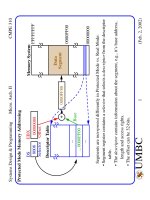Thiết kế và lập trình hệ thống - Chương 27
Bạn đang xem bản rút gọn của tài liệu. Xem và tải ngay bản đầy đủ của tài liệu tại đây (352.93 KB, 17 trang )
Systems Design & Programming Linux Device Drivers I CMPE 310
1 (April 18, 2002)
UMBC
U M B C
U
N
I
V
E
R
S
I
T
Y
O
F
M
A
R
Y
L
A
N
D
B
A
L
T
I
M
O
R
E
C
O
U
N
T
Y
1
9
6
6
Kernel and Driver Fundamentals
Reference:
“Linux Device Drivers”, Alessandro Rubini, O’Reilly, 2nd Edition
Free on-line version at:
/>Pointers:
/> /> /> /> /> /> />Driver examples:
/>Systems Design & Programming Linux Device Drivers I CMPE 310
2 (April 18, 2002)
UMBC
U M B C
U
N
I
V
E
R
S
I
T
Y
O
F
M
A
R
Y
L
A
N
D
B
A
L
T
I
M
O
R
E
C
O
U
N
T
Y
1
9
6
6
Kernel and Driver Fundamentals
Device drivers provide mechanisms, not policy.
Mechanism: “Defines what capabilities are provided?”
Policy: “Defines how those capabilities can be used?”
This strategy allows flexibility.
The driver controls the hardware and provides an abstract interface to its
capabilities.
The driver ideally imposes no restrictions (or policy) on how the hard-
ware should be used by applications.
For example, X manages the graphics hardware and provides an interface to
user programs.
Window managers implement a particular policy and know nothing about
the hardware.
Kernel apps build policies on top of the driver, e.g. floppy disk, such as who
has access, the type of access (direct or as a filesystem), etc.
Floppy is policy free -- it makes the disk look like an array of blocks.
Systems Design & Programming Linux Device Drivers I CMPE 310
3 (April 18, 2002)
UMBC
U M B C
U
N
I
V
E
R
S
I
T
Y
O
F
M
A
R
Y
L
A
N
D
B
A
L
T
I
M
O
R
E
C
O
U
N
T
Y
1
9
6
6
Kernel and Driver Fundamentals
Kernel Parts:
Process management:
Kernel is responsible for creating, destroying and scheduling pro-
cesses.
Memory management:
Kernel implements a virtual memory space on top of the limited
physical resources.
File systems:
Almost everything in Unix can be treated as a fi le (fi le abstraction).
The kernel builds a structured fi lesystem on top of unstructured
hardware.
Device control:
The kernel must have a device driver for every peripheral present on
the system.
Networking:
Kernel collects, identifi es, dispatches and receives data packets to/
from network interfaces and user programs.
Systems Design & Programming Linux Device Drivers I CMPE 310
4 (April 18, 2002)
UMBC
U M B C
U
N
I
V
E
R
S
I
T
Y
O
F
M
A
R
Y
L
A
N
D
B
A
L
T
I
M
O
R
E
C
O
U
N
T
Y
1
9
6
6
Kernel and Driver Fundamentals
User Programs and Applications
Process
Management
Memory
Management
File
Systems
Device
Control
Networking
Kernel
Parts
Concurrency
Multitasking
Virtual
Memory
Files &
Directories
TTYs &
Device Access
Connectivity
Features
Architecture
Dependent
Code
CPU
RAM
Memory
Manager
Disks &
CDs
FS types
Block Dev
Character
Devices
Network
Subsystem
IF Drivers
Hardware
Console,
Network
Serial Ports
Special Brds
Interfaces
Soft Support
Hardware
Control
Systems Design & Programming Linux Device Drivers I CMPE 310
5 (April 18, 2002)
UMBC
U M B C
U
N
I
V
E
R
S
I
T
Y
O
F
M
A
R
Y
L
A
N
D
B
A
L
T
I
M
O
R
E
C
O
U
N
T
Y
1
9
6
6
Kernel and Driver Fundamentals
Modules:
A method by which you can expand the kernel code at run time.
A module is made up of object code (not stand-alone code) that can be
linked (insmod) and unlinked (rmmod) to a running kernel.
This provides a nice way for you to install and test device drivers.
Device classifi cation:
Most device drivers can be classifi ed into one of three categories.
• Character devices.
Console and parallel ports are examples.
Implement a stream abstraction with operations such as open, close,
read and write system calls.
File system nodes such as /dev/tty1 and /dev/lp1 are used to access
character devices.
Differ from regular fi les in that you usually cannot step backward in
a stream.
Systems Design & Programming Linux Device Drivers I CMPE 310
6 (April 18, 2002)
UMBC
U M B C
U
N
I
V
E
R
S
I
T
Y
O
F
M
A
R
Y
L
A
N
D
B
A
L
T
I
M
O
R
E
C
O
U
N
T
Y
1
9
6
6
Kernel and Driver Fundamentals
Device classifi cation:
• Block devices.
A block device is something that can host a fi lesystem, e.g. disk, and
can be accessed only as multiples of a block.
Linux allows users to treat block devices as character devices (/dev/
hda1) with transfers of any number of bytes.
Block and character devices differ primarily in the way data is man-
aged internally by the kernel at the kernel/driver interface.
The difference between block and char is transparent to the user.
• Network interfaces.
In charge of sending and receiving data packets.
Network interfaces are not stream-oriented and therefore, are not
easily mapped to a node in the fi lesystem, such as /dev/tty1.
Communication between the kernel and network driver is not
through read/write, but rather through packet transfer functions.









